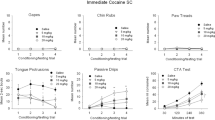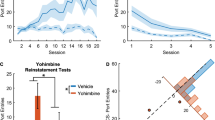Abstract
Previous research has found that swim stress during a classical conditioning trial attenuates conditioned taste aversion (CTA). In the current study, rats were used to examine the effects of inescapable swim stress on the habituation of neophobia to a flavored solution and reacquisition of an extinguished conditioned taste aversion. In Experiment 1, subjects were initially exposed to a taste, with some subjects receiving a swim experience to assess the level of neophobia on a subsequent taste-exposure test. Rats in Experiment 2 were given a taste-LiCl trial followed by extensive CS-alone extinction trials. Subjects then received the taste-LiCl pairing again, followed for some by a swim experience to examine its effect on subsequent reconditioning. Swim stress influenced CS processing on the final extinction trial. Thus, reacquisition was attenuated by swim, but there was no effect of swim stress on the attenuation of neophobia. These results are discussed in terms of the effects of stress on CS processing.
Similar content being viewed by others
References
BERMUDEZ-RATTONI, F. (2004). Molecular mechanisms of taste recognition memory. Nature Reviews: Neuroscience, 5, 209–217. doi:10.1038/nrn1344
BOURNE, M. J., CALTON, J. L., GUSTAVSON, K. K., & SCHACHTMAN, T. R. (1992). Effects of acute swim stress on LiCl-induced conditioned taste aversion in rats. Physiology & behavior, 51, 1227–1234. doi:10.1016/j.bbr.2011.03.031
BOUTON, M. E. (1986). Slow reacquisition following extinction of conditioned suppression. Learning and Motivation, 17, 1–15. doi:10.1016/0023-9690(86)90017-2
BOUTON, M. E., & SWARTZENTRUBER, D. (1989). Slow reacquisition following extinction: Context, encoding, and retrieval mechanisms. Journal of Experimental Psychology: Animal Behavior Processes, 15, 43–53. doi:10.1037/0097-7403.15.1.43
CALTON, J. L., MITCHELL, K. G., & SCHACHTMAN, T. R. (1996). Retardation and summation tests of an extinguished conditioned excitor. Learning & Motivation, 27, 335–361. doi:10.1006/lmot.1996.0020
DANGUIR, J., & NICOLAIDIS, S. (1977). Lack of reacquisition in learned taste aversions. Animal Learning & behavior, 5, 395–397. doi:10.3758/Bf03209585
DOMJAN, M. (1977). Attenuation and enhancement of neophobia for edible substances. In L. M. Barker, M. Best, & M. Domjan (eds.), Learning mechanisms in food selection. Waco, Texas: Baylor University Press.
GREEN, K. F., & PARKER, L. A. (1975). Gustatory memory: Incubation and interference. Behavioural Biology, 13, 359–367. doi:10.1016/S0091-6773(75)91416-9
GUTIERREZ, R., TELLEZ, L. A., & BERMUDEZ-RATTONI, F. (2003). Blockade of cortical muscarinic but not Nmda receptors prevents a novel taste from becoming familiar. European Journal of Neuroscience, 17, 1556–1562. doi:10.1046/j.1460-9568.2003.02608.x
HALL, G., & PEARCE, J. M. (1982). Restoring the associability of a pre-exposed Cs by a surprising event. Quarterly Journal of Experimental Psychology, 34B, 127–140. doi:10.1080/14640748208400881
HART, J. A., BOURNE, M. J., & SCHACHTMAN, T. R. (1995). Slow reacquisition of a conditioned taste aversion. Animal Learning & behavior, 23, 297–303. doi:10.3758/Bf03198926
KASPROW, W. J., & SCHACHTMAN, T. R. (1993). Differential effects of distractor stimuli and the interval between favor exposures on neophobia and latent inhibition. The Psychological Record, 43, 25–38.
KAYE, H., GAMBINI, B., & MACKINTOSH, N. J. (1988). A dissociation between one-trial overshadowing and the effect of a distractor on habituation. Quarterly Journal of Experimental Psychology, 40B, 31–47. doi:10.1080/14640748808402307
LUBOW, R. E., & MOORE, A. U. (1959). Latent inhibition: The effect of non-reinforced pre-exposure to the conditional stimulus. Journal of Comparative and Physiological Psychology, 52, 415–419. doi:10.1037/h0046700
LUBOW, R. E. (1989). Latent inhibition and conditioned attention theory. New York: Cambridge University Press.
MACKINTOSH, N. J. (1987). Neurobiology, psychology and habituation. Behavior Research & Therapy, 25, 81–97. doi:10.1016/0005-7967(87)90079-9
MASAKI, T., & NAKAJIMA, S. (2006). Taste aversion in rats induced by forced swimming, voluntary running, forced running, and lithium chloride injection treatments. Physiology & Behavior, 88, 411–416. doi:10.1016/j.physbeh.2006.04.013
NAKAJIMA, S., & MASAKI, T. (2004). Taste aversion learning induced by delayed swimming activity. Behavioural Processes, 67, 357–362. doi:10.1016/j.beproc.2004.06.005
PAYNE, J. D., NADEL, L., BRITTON, W. B., & JACOBS, W. J. (2004). The biopsychology of trauma and memory. In D. Reisberg & P. Hertel (eds.), Memory and emotion (pp. 76–128). New York: Oxford University Press.
PEARCE, J. M., & HALL, G. (1980). A model for Pavlovian learning: variations in the effectiveness of conditioned but not of unconditioned stimuli. Psychological Review, 87, 532–552. doi:10.1037/0033-295X.87.6.532
RADA, P., COLASANTE, C., SKIRZEWSKI, M., HERNANDEZ, L., & HOEBEL, B. (2006). Behavioral depression in the swim stress test causes a biphasic, long-lasting change in accumbens acetylcholine release, with partial compensation by acetylcholinesterase and muscarinic-1 receptors. Neuroscience, 141, 67–76. doi:10.1016/j.neuroscience.2006.03.043
REVUSKY, S., & REILLY, S. (1989). Attenuation of conditioned taste aversion by external stressors. Pharmacology, Biochemistry, & behavior, 33, 219–226. doi:10.1016/0091-3057(89)90453-X
ROBERTSON, D., & GARRUD, P. (1983). Variable processing of favors in rat Stm. Animal Learning & behavior, 11, 474–482. doi:10.3758/Bf03199804
SMITH, S., FIESER, S., JONES, J., & SCHACHTMAN, T. R. (2008). Effects of swim stress on latent inhibition using a conditioned taste aversion procedure. Physiology & behavior, 95, 539–541. doi:10.1016/j.physbeh.2008.06.014
WAGNER, A. R. (1976). expectancies and priming in Stm. In S. H. Hulse, H. Fowler, & W. K. Honig (eds.), Cognitive processes in animal behavior (pp. 177–209). Hillsdale, NJ: Erlbaum.
WAGNER, A. R., RUDY, J. W., & WHITLOW, J. W. (1973). Rehearsal in animal conditioning. Journal of Experimental Psychology Monographs, 97, 407–426. doi:10.1037 /h0034136
WHITEHOUSE, W. G., BLUSTEIN, J. E., WALKER, J., BERSH, P. J., & MARGULES, D. L. (1985). Shock controllability and opiate substrates of escape performance and nociception: Differential effects of peripherally and centrally acting naltrexone. Behavioral Neuroscience, 99, 717–733. doi:10.1037/0735-7044.99.4.717
Author information
Authors and Affiliations
Corresponding author
Rights and permissions
About this article
Cite this article
Walker, J.M., Ramsey, A.K., Fowler, S.W. et al. Effects of Swim Stress on Ne ophobia and Re conditioning Using a Conditioned Taste Aversion Procedure. Psychol Rec 62, 295–306 (2012). https://doi.org/10.1007/BF03395803
Published:
Issue Date:
DOI: https://doi.org/10.1007/BF03395803




